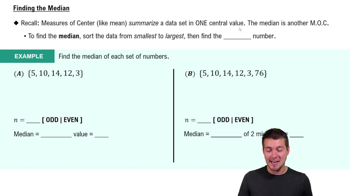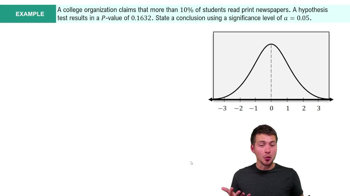Requirements Assume that we want to use the data from Exercise 1 with the Kruskal-Wallis test. Are the requirements satisfied? Explain.
Table of contents
- 1. Intro to Stats and Collecting Data1h 14m
- 2. Describing Data with Tables and Graphs1h 55m
- 3. Describing Data Numerically2h 5m
- 4. Probability2h 16m
- 5. Binomial Distribution & Discrete Random Variables3h 6m
- 6. Normal Distribution and Continuous Random Variables2h 11m
- 7. Sampling Distributions & Confidence Intervals: Mean3h 23m
- Sampling Distribution of the Sample Mean and Central Limit Theorem19m
- Distribution of Sample Mean - Excel23m
- Introduction to Confidence Intervals15m
- Confidence Intervals for Population Mean1h 18m
- Determining the Minimum Sample Size Required12m
- Finding Probabilities and T Critical Values - Excel28m
- Confidence Intervals for Population Means - Excel25m
- 8. Sampling Distributions & Confidence Intervals: Proportion1h 12m
- 9. Hypothesis Testing for One Sample3h 29m
- 10. Hypothesis Testing for Two Samples4h 50m
- Two Proportions1h 13m
- Two Proportions Hypothesis Test - Excel28m
- Two Means - Unknown, Unequal Variance1h 3m
- Two Means - Unknown Variances Hypothesis Test - Excel12m
- Two Means - Unknown, Equal Variance15m
- Two Means - Unknown, Equal Variances Hypothesis Test - Excel9m
- Two Means - Known Variance12m
- Two Means - Sigma Known Hypothesis Test - Excel21m
- Two Means - Matched Pairs (Dependent Samples)42m
- Matched Pairs Hypothesis Test - Excel12m
- 11. Correlation1h 6m
- 12. Regression1h 50m
- 13. Chi-Square Tests & Goodness of Fit1h 57m
- 14. ANOVA1h 57m
9. Hypothesis Testing for One Sample
Steps in Hypothesis Testing
Problem 13.5.6
Textbook Question
Arsenic in Rice Listed below are amounts of arsenic in samples of brown rice from three different states. The amounts are in micrograms of arsenic and all samples have the same serving size. The data are from the Food and Drug Administration. Use a 0.01 significance level to test the claim that the three samples are from populations with the same median.

 Verified step by step guidance
Verified step by step guidance1
Step 1: Identify the appropriate statistical test for comparing medians across three independent groups. Since the problem involves testing the claim that the three samples are from populations with the same median, and the data is not assumed to be normally distributed, use the Kruskal-Wallis test, a non-parametric method.
Step 2: Organize the data into ranks. Combine all the data from Arkansas, California, and the third state (not visible in the image). Rank the values from smallest to largest, assigning average ranks to tied values.
Step 3: Calculate the test statistic for the Kruskal-Wallis test. Use the formula: , where N is the total number of observations, Ri is the sum of ranks for each group, and ni is the number of observations in each group.
Step 4: Determine the critical value for the Kruskal-Wallis test at the 0.01 significance level. Use the chi-square distribution table with degrees of freedom equal to the number of groups minus one (df = 3 - 1 = 2).
Step 5: Compare the calculated test statistic (H) to the critical value. If H exceeds the critical value, reject the null hypothesis and conclude that the medians of the populations are not the same. Otherwise, fail to reject the null hypothesis.
 Verified video answer for a similar problem:
Verified video answer for a similar problem:This video solution was recommended by our tutors as helpful for the problem above
Video duration:
6mPlay a video:
Was this helpful?
Key Concepts
Here are the essential concepts you must grasp in order to answer the question correctly.
Median
The median is the middle value in a data set when the numbers are arranged in ascending order. It is a measure of central tendency that is less affected by outliers than the mean, making it particularly useful for skewed distributions. In this context, comparing the medians of arsenic levels in rice samples from different states helps assess whether the populations have similar exposure levels.
Recommended video:
Guided course

Calculating the Median
Hypothesis Testing
Hypothesis testing is a statistical method used to make inferences about population parameters based on sample data. It involves formulating a null hypothesis (e.g., the medians are equal) and an alternative hypothesis (e.g., the medians are not equal). A significance level, such as 0.01, is chosen to determine the threshold for rejecting the null hypothesis based on the test statistic calculated from the data.
Recommended video:
Guided course

Step 1: Write Hypotheses
Significance Level
The significance level, often denoted as alpha (α), is the probability of rejecting the null hypothesis when it is actually true. In this case, a significance level of 0.01 indicates a 1% risk of concluding that there is a difference in medians when there is none. This level is chosen to minimize the likelihood of Type I errors, which can be critical in health-related studies like arsenic exposure.
Recommended video:
Guided course

Step 4: State Conclusion Example 4

 6:21m
6:21mWatch next
Master Step 1: Write Hypotheses with a bite sized video explanation from Patrick
Start learningRelated Videos
Related Practice
